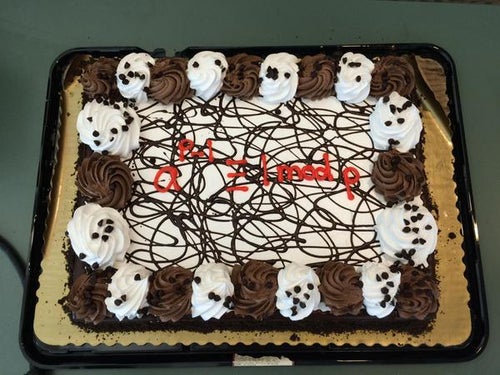This article was published in Scientific American’s former blog network and reflects the views of the author, not necessarily those of Scientific American
My first musical love was Beethoven. The 2nd movement of Beethoven’s 7th Symphony was the first piece of music that made me want to cry. When I started to play viola, the cello suites were the gateway to my long, passionate relationship with Bach. In college, I fell hard for Prokofiev and Shostakovich. I couldn't keep the tears out of my eyes when my college orchestra played Shostakovich's 5th symphony. But I never got there with Mozart. I was a classical music lover who didn’t care for Classical music.
Except for Ave Verum Corpus. Now that was a beautiful piece of music. I didn’t like Mozart except for that one song. Well, and the Requiem. The Kyrie sent chills up my spine. But the rest of it was just bland elevator music to me.
And then I heard the Sinfonia Concertante. And really listened to the Jupiter Symphony for the first time. I played one of the Kegelstatt trios and string quartet 19. After a while, I realized my “I don’t like Mozart except for…” list was getting uncomfortably long. I had to admit that I liked Mozart, full stop. He’ll never be my favorite, but I can’t pretend that he just wrote elevator music.
On supporting science journalism
If you're enjoying this article, consider supporting our award-winning journalism by subscribing. By purchasing a subscription you are helping to ensure the future of impactful stories about the discoveries and ideas shaping our world today.
My great mathematical love is geometry, especially of the hyperbolic flavor. Numbers never really did it for me. As I learned more and more math, I developed a slight disdain for number theory. What’s so great about easy to state, hard to prove conjectures? I was a classical music lover who didn’t like Classical music and a mathematician who didn’t like numbers.
That changed when I taught number theory to high schoolers this summer. Although I thought about teaching geometry instead, number theory was a logical choice for a few reasons. There is a low barrier to entry, and number theory ties in well with the coding we do in the program. And those easy to state, hard to prove conjectures give young mathematicians a glimpse of math questions that don’t have pre-packaged answers.
We started the course with modular arithmetic, the foundation of number theory. Modular arithmetic can be daunting to the uninitiated, but we actually use it every day. In mod 12 arithmetic, any two integers that are separated by some number of twelves are considered equivalent: 1, 13, 25, and 37 are all the same mod 12. Addition and multiplication work the same way as in regular arithmetic except that we reset to zero when we get to 12. So 7+6=1, not 13. (You’re allowed to call it 13 if you want, as long as you agree that it’s functionally equivalent to 1.)
If you start playing with it a little bit, you’ll find the mod 12 system familiar: modular arithmetic is sometimes called clock arithmetic because 10:00 plus 1 hour is the same number on the clock as 10:00 plus 13 hours or 10:00 plus 25 hours. 1 pm today is not actually the same as 1 pm tomorrow, but our system of recording time makes it convenient for us to give the same label to times that differ by 24 hours. Similarly, we use mod 7 arithmetic for days of the week and mod 365-ish arithmetic for dates of the year. The Mayan calendar “end of the world” hubbub a few Decembers ago boiled down to applied mod 1,872,000 arithmetic.
In college and grad school, I learned some basics of modular arithmetic, but like Mozart’s music, it didn’t grab me. It seemed like a collection of party tricks. Is there a power of 3 whose last digits are 001? Modular arithmetic has the answer! Modular arithmetic is also the engine for RSA encryption, which is believed to be one of the most secure ways to keep data safe in public. (The key to the security of RSA is another number theory problem: it takes a long time to factor big numbers.) But I’m a theoretical mathematician—practical concerns such as cybersecurity don’t really sell me on a mathematical topic. I was condemned to live out my days with an inadequate appreciation of number theory.
And then I taught my students Fermat’s Little Theorem, a fundamental result about exponentiation in modular arithmetic. And we explored the structure of modular multiplication tables gave. I finally cared about the Chinese remainder theorem, which shows the relationship between modular arithmetic systems with different bases. (That is, can you find a number that is 2 mod 3 and 4 mod 5?) Really digging into RSA and other number theory-based cryptosystems gave me a new appreciation for their elegance. The icing on the cake was spending part of last Saturday morning with my spouse and a tough little modular arithmetic problem. We had so much fun!

Sometimes even a cake likes to dress up pretty and tell people about Fermat's Little Theorem. Credit: Evelyn Lamb
Now I must apologize to Mozart, who is dead, and modular arithmetic, which is not a sentient being and therefore doesn't care about apologies. I’m sorry, Mozart, that I thought you wrote boring elevator music. I should be so lucky to get on an elevator filled with the beauty you created. I’m sorry, modular arithmetic, that I thought you were just full of parlor tricks. You do have plenty of parlor tricks, but there’s deep, beautiful structure there as well. I should have recognized it sooner and I hope you can find it in your heart to forgive me.